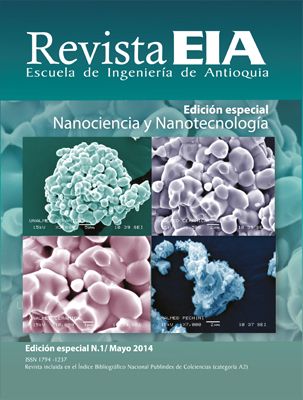Obtención de precursores con tamaño de partícula nano y micrométrico para la fabricación de materiales cerámicos con propiedades eléctricas no lineales
Obtención de precursores con tamaño de partícula nano y micrométrico para la fabricación de materiales cerámicos con propiedades eléctricas no lineales


This work is licensed under a Creative Commons Attribution-NonCommercial-NoDerivatives 4.0 International License.
Copyright statement
The authors exclusively assign to the Universidad EIA, with the power to assign to third parties, all the exploitation rights that derive from the works that are accepted for publication in the Revista EIA, as well as in any product derived from it and, in in particular, those of reproduction, distribution, public communication (including interactive making available) and transformation (including adaptation, modification and, where appropriate, translation), for all types of exploitation (by way of example and not limitation : in paper, electronic, online, computer or audiovisual format, as well as in any other format, even for promotional or advertising purposes and / or for the production of derivative products), for a worldwide territorial scope and for the entire duration of the rights provided for in the current published text of the Intellectual Property Law. This assignment will be made by the authors without the right to any type of remuneration or compensation.
Consequently, the author may not publish or disseminate the works that are selected for publication in the Revista EIA, neither totally nor partially, nor authorize their publication to third parties, without the prior express authorization, requested and granted in writing, from the Univeridad EIA.
Show authors biography
Se comparan resultados respecto al comportamiento eléctrico del material sinterizado, a partir de polvos precursores de materiales cerámicos con propiedades eléctricas no lineales, conocidos como varistores. Los rutas de síntesis investigadas buscando reducir el tamaño de partícula a distribuciones nanométricas, son de precipitación controlada, método Pechini y el método tradicional de mezcla de óxidos. La matriz de los polvos se basa en ZnO dopado con óxidos de Bi, Mn y Sb y se realizan seguimientos en etapas intermedias y finales del proceso por medio de las técnicas Difracción de Rayos x y microscopía electrónica de barrido. Se analizan los resultados del proceso de sinterización es- tablecido según programas de temperatura-tiempo del material precursor, tomando como base las técnicas de Análisis Termogravimétrico y Análisis Térmico Diferencial. Se muestra la superioridad de las rutas químicas respecto a la mezcla de óxidos ya que permiten obtener menores tamaños de partícula, menores temperaturas de densificación, y mejores respuestas eléctricas las cuales están dadas por coeficientes de no linealidad mayores y corrientes de fuga menores.
Abstract: Results are compared with respect to electrical performance of the sintered material from ceramics precursor powders with nonlinear electrical properties, known as varistors. The synthesis routes investigated to reduce the particle size to nanometer distributions are controlled precipitation, Pechini method and the traditional method of mixed oxides. The matrix of the powders is based on ZnO doped with Bi, Mn and Sb and monitoring is made on intermediate and final stages of the process by x-ray diffraction and scanning electron microscopy. We analyze the results of the sintering process established under temperature-time programs of the precursor material, based on Thermo gravimetric Analysis techniques and Differential Thermal Analysis. The results show the superiority of the chemical routes compared to the mixture of oxides since with the former it is possible to obtain smaller particle sizes, lower densification temperature, and improved electrical responses given by higher nonlinearity coefficients and lower leakage currents.
Article visits 289 | PDF visits 137
